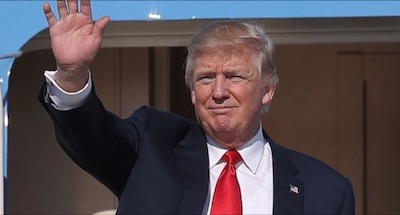 Following President Donald Trump’s midnight tweet about “covfefe,” the U.S. Patent and Trademark Office (USPTO) has received more than 30 trademark requests containing the word “covfefe.”
Following President Donald Trump’s midnight tweet about “covfefe,” the U.S. Patent and Trademark Office (USPTO) has received more than 30 trademark requests containing the word “covfefe.”
The 32 trademark requests include two hashtag versions of the word, two companies seeking to claim the phrase “Covfefe Coffee” and 25 attempts to trademark the word alone. The requests were submitted both by companies and individuals, including a New York man who wants to use the word to sell clothing for domestic pets as well as costumes, footwear, hats and maternity outfits for humans.
A few weeks ago, Representative Mike Quigley of Illinois introduced the “Communications Over Various Feeds Electronically for Engagement” Act, or the COVFEFE Act, that would modify the Presidential Records Act and require the National Archives to archive presidential tweets and other social media posts. Many of these trademark files, however, likely misunderstand what a trademark really is, and how one acquires trademark rights in a term like “covfefe.”
Jason Rosenberg, partner in Alston & Bird’s IP Trademarks & Copyrights Practice Group, recently sat down with IPWatchdog to discuss who, if anyone, actually owns the rights to “covfefe.”
“Filing a trademark application with the goal of claiming a right to a particular term – with nothing more – is a fundamental misunderstanding of our trademark laws,” he said. “Individuals and corporations rushing to design t-shirts and coffee mugs with phrases like ‘What the covfefe?’ on them aren’t likely to be able to claim ownership of the term, or stop anyone else from using it. You cannot simply hear a word you like, file a trademark application, and claim it as your own. In the United States, the law requires more.”
No one can really own a word, at least not in and of itself, according to Rosenberg. If a word is used as a trademark, however – meaning, it is used to identify a particular product or service – the owner of the mark can prevent others from using it to sell similar products or services. For instance, the company Apple doesn’t own the word “apple,” but they certainly own the trademark Apple for computers and mobile devices. Given the number of trademark applications for “covfefe” marks – 34 as of June 28 – it is unlikely that any of those applicants could ever obtain completely exclusive rights to use the term.
So, how exactly would someone acquire trademark rights to a word like “covfefe”?
According to Rosenberg, in the U.S., trademark rights are acquired through use of the trademark in commerce, not by filing an application to register the mark. This is different than in many other countries. In the U.S., having your trademark registered provides some additional statutory benefits, like having national priority to the mark, and the ability to register the mark with Customs to help stop counterfeits. But, unless and until you’re using your mark to identify your products, and offering them for sale, you do not have any trademark rights.
However, it is still possible that someone could end up owning the word “covfefe” as a trademark. Actually, Rosenberg said that several people could, for various goods or services. If someone makes proper trademark usage of the word, using it to identify his or her brand, then in theory, sure, there is no reason it couldn’t function as a trademark.
“Some of the strongest and most well-known trademarks in the world are not real words, like Haagen-Dazs,” he explained. “But, many of the trademark applications are likely to fail, because the applicants don’t understand that just putting the word ‘covfefe’ on a t-shirt or coffee mug is not likely to be considered trademark use.”
Many people think that by filing a trademark application they can claim a word for their own – and prevent others from using it – without using the mark themselves. For example, if you printed a t-shirt that said, “What the covfefe?,” you are very unlikely to have acquired any trademark rights, because that is not going to be considered a proper trademark use.
But, what is a proper trademark use?
“The kind that tells the consumer who made the product,” explained Rosenberg. “In the t-shirt example, it’s probably the label typically attached at the back of the neck. That’s not to say that someone couldn’t sell Covfefe brand t-shirts, Covfefe brand mugs, Covfefe brand plumbing supplies, or even Covfefe brand accounting services. But to acquire trademark rights, the person will need to use the term as a trademark – a source identifier – which is more than just putting a funny word on a shirt.”
In fact, of the 34 applications, all but only three are actually “intent to use” applications. This means that the applicant is saying that they plan on using the mark in the future, but haven’t started yet. Eventually, they’ll have to prove use or the applications will be rejected.

![[IPWatchdog Logo]](https://ipwatchdog.com/wp-content/themes/IPWatchdog%20-%202023/assets/images/temp/logo-small@2x.png)

![[Advertisement]](https://ipwatchdog.com/wp-content/uploads/2024/04/Patent-Litigation-Masters-2024-sidebar-early-bird-ends-Apr-21-last-chance-700x500-1.jpg)

![[Advertisement]](https://ipwatchdog.com/wp-content/uploads/2021/12/WEBINAR-336-x-280-px.png)
![[Advertisement]](https://ipwatchdog.com/wp-content/uploads/2021/12/2021-Patent-Practice-on-Demand-recorded-Feb-2021-336-x-280.jpg)
![[Advertisement]](https://ipwatchdog.com/wp-content/uploads/2021/12/Ad-4-The-Invent-Patent-System™.png)







Join the Discussion
No comments yet.